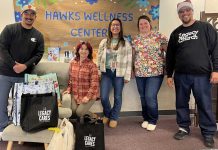Nestled below the unassuming agricultural fields and rolling
hills of San Benito County lies thousands of years of human
history.
Hollister – Nestled below the unassuming agricultural fields and rolling hills of San Benito County lies thousands of years of human history.
The now crumbling, dirt-covered remains of the first San Benitoites, ancestors of the Ohlone American Indian tribe, serve as silent ambassadors of the past whose antiquated existence remains buried and forgotten until unexpectedly unearthed by a workman’s pick or shovel.
While doing construction work on private property north of Hollister near San Felipe Road, workers with Pacific Sod stumbled upon some of these human remains last Thursday, said sheriff’s Detective Jeff Goodwin.
“They were attempting to locate a water pipe, to put a fence in,” he said. “And in the process they dug up some bones.”
The remains, which included a fairly large piece of a human skull and part of a jaw bone and teeth, were several feet below the ground when the workers discovered them, Goodwin said.
The workers immediately contacted
sheriff’s deputies, who collected the portion of excavated remains and called the California Native American Heritage Commission in Sacramento, Goodwin said. The commission then contacted local Ohlone descendant, Anne-Marie Sayers, to take responsibility of the remains.
Within the last five years, Goodwin said about four different burial sites have been found within three-square miles of last week’s find.
Sayers said tribal remains are discovered quite often in San Benito County because of the group’s prevalence in this area dating back 10,000 years. While there is no way to determine how old the bones are at this time, analysis done several years ago on a number of burials near the San Felipe Road location determined those remains to be between 3,000 and 3,500 years old, she said. How much of the skeleton remains, what the sex was or how old the individual was when they died and were buried near what is now considered the Dunneville area, is unknown and may never be known.
Archaeologists can perform a technique called Carbon 14 dating to determine how old the remains are, but because it destroys portions of the bones Sayers said she prefers not to process them in that manner.
The are a number of different ways to determine if the remains are Native American, including analyzing the teeth and the opening of the ear, which is oval instead of round like Europeans’ ears, she said.
“If the teeth are ground down it’s a good indication it’s a Native American burial,” she said, adding the remains found last week indicated as such. “Local native people relied heavily on acorns and a variety of seeds high in protein.”
The California Native American Heritage Commission, which is the primary government agency responsible for identifying and cataloging Native American cultural resources, determined Sayers was the “most likely descendant” of the remains, said CNAHC Environmental Specialist Debbie Treadway.
Her role as the descendant is to make a recommendation to the property owner of what to do with the remains, Treadway said.
Sayers said her recommendation is to have an archaeologist remove the rest of the remains and re-bury them in an area near the site where they won’t be disturbed. Although no action has been taken yet, Sayers said the owner seemed acceptable to her recommendation.
“They have to be re-interred ceremonially,” Sayers said. “A lot of Native American people believe when burials are disturbed the spirit of the individual is wandering until they are re-interred ceremonially.” She hopes to have the remains moved and buried as soon as possible, but said it is ultimately up to the property owner to determine when they will go back in the ground, and where the final resting place will be.
Sayers said she will conduct the ceremony, but wouldn’t go into detail about the ritual except that it’s deeply rooted in tradition. She also emphasized that photographing the remains is severely frowned upon and just isn’t done in Native American culture.
“We live in a society so absent of the sacred,” she said. “If you understand sacredness, (you know) it’s personal. Would you like your grandmother’s remains shown publicly?”
Sayers wasn’t certain if the area where the remains were found was considered an Ohlone cemetery. However, the site is located near an area where archaeologists removed seven different burials 12 years ago, which would constitute a cemetery, she said.
Because ancient Ohlone remains pervade several different areas of the county, anytime someone uncovers a burial they are required by law to discontinue any further excavation until the coroner’s office arrives to analyze the bones, Sayers said. Knowingly desecrating a burial is a crime and can result in a fine or jail time, according to state law.
“It’s important to know what to do,” she said. “This county was inhabited by Ohlone peoples for tens of thousands of years.”
For more information about Native American burials and remains log onto www.nahc.ca.gov
Erin Musgrave covers public safety for the Free Lance. Reach her at 637-5566, ext. 336 or em*******@***********ws.com









